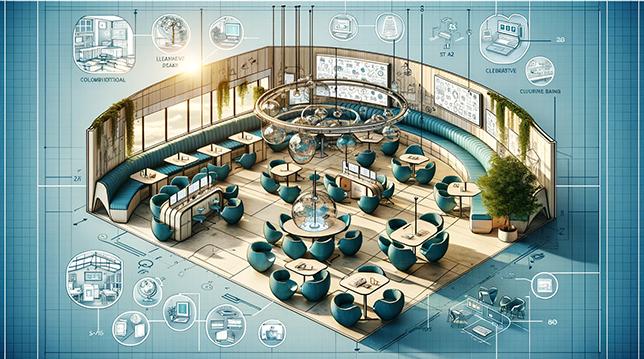Hybrid Classrooms: Innovative Strategies for Flexible Learning Design
the education landscape is evolving rapidly, and hybrid classrooms are at the forefront of this change. Combining the best aspects of traditional face-to-face learning wiht online education, hybrid or blended learning environments offer exceptional versatility for students and educators alike. In this comprehensive guide, we delve into innovative strategies for flexible learning design in hybrid classrooms, covering actionable tips, proven benefits, real-world examples, and essential best practices for successful implementation.
Understanding Hybrid Classrooms
Hybrid classrooms, also known as blended classrooms, integrate in-person and online learning experiences. This flexible approach allows students to attend classes physically or remotely, enabling seamless participation regardless of location.
- In-Person Component: Traditional face-to-face instruction in a physical classroom.
- Online Component: Virtual learning delivered via digital platforms, often using tools like Zoom, Microsoft Teams, or Google Classroom.
- Asynchronous Opportunities: Recorded lectures and coursework that students can complete on their own schedule.
The Benefits of Hybrid Classrooms
Adopting innovative hybrid classroom strategies unlocks myriad benefits for students, teachers, and educational institutions:
- Flexibility: Students can learn in-person or online, accommodating personal schedules and learning preferences.
- Accessibility: Learners can access materials and participate from anywhere, reducing geographical barriers.
- Scalability: Hybrid models make it easier to adjust class sizes and reach more students.
- Personalization: Opportunities for differentiated instruction to cater to diverse learning needs.
- Continuity: Learning remains uninterrupted during disruptions (e.g., public health emergencies, weather events).
- Increased Engagement: Interactive digital tools and diverse learning formats captivate students and foster active participation.
Innovative Strategies for Flexible Learning Design in Hybrid Classrooms
Effective hybrid teaching requires intentional planning and the adoption of creative strategies that leverage the strengths of both in-person and online modalities. Here are proven methods to enhance your hybrid classroom design:
1.flipped Classroom Approach
-
Students review lectures or core content online as homework.
-
Synchronous (in-person or online) class time is devoted to discussions, problem-solving, and collaborative activities.
- Benefits: Encourages deeper understanding, peer-to-peer interaction, and active learning.
2. universal Design for Learning (UDL)
-
Design lessons with multiple means of engagement, representation, and expression to address diverse learning preferences.
-
Incorporate multimedia, varied assessments, and accessible materials to promote equity and inclusion.
3.Synchronous and Asynchronous Blending
-
Combine live sessions (e.g., lectures, Q&A) with self-paced activities (discussion boards, recorded videos, readings).
-
Enables students to engage at their own pace while benefiting from real-time interaction.
4. Leverage Technology for Collaboration
-
Harness collaborative tools like Google Workspace, Padlet, Jamboard, and breakout rooms to facilitate group projects and peer feedback.
-
Use learning management systems (LMS) like Moodle, Canvas, or Blackboard to centralize resources, assignments, and communications.
5. Real-time Feedback and Assessment
-
Utilize quizzes, polls, and instant messaging for formative assessment during live sessions.
-
Provide timely feedback through digital tools, enhancing learner progress tracking and motivation.
6. Consistent Communication Channels
-
Establish clear communication protocols—such as, weekly newsletters, scheduled office hours, and centralized announcements.
-
Encourage students to share their questions and feedback regularly.
Best Practices for Hybrid Learning Environments
To maximize the impact of hybrid classrooms, educators should follow a well-defined set of best practices:
- Set Clear Expectations: Clarify attendance, participation, and assessment criteria for both onsite and remote learners.
- Design Inclusive Content: Ensure all materials are accessible for students with disabilities (e.g., captions for videos, readable documents).
- Foster Community: Use icebreakers, discussion forums, and group projects to build a sense of belonging.
- Train Faculty and Students: provide professional development and digital literacy support for all stakeholders.
- Gather Feedback: Regularly survey students and staff to identify areas for advancement.
Case Study: Hybrid Classroom Success in Action
Let’s examine how a university leveraged hybrid learning design during the COVID-19 pandemic to deliver high-quality education:
- Context: Large introductory courses with over 150 students faced notable challenges with physical distancing.
- Solution: the institution adopted a rotating attendance model—half the class attended in person, while the other half joined via high-quality live streams and participated through chat and polls.
- Implementation: Lectures were recorded and available for asynchronous viewing. Breakout sessions allowed remote students to collaborate in real-time.
- Results: student engagement scores increased, and academic performance remained steady compared to pre-pandemic years. Surveys showed high satisfaction with the hybrid format’s flexibility.
Firsthand Experience: Teacher’s Perspective on Hybrid Education
“Teaching in a hybrid classroom challenged me to rethink my instructional strategies. Using online discussion boards alongside in-class debates enriched student participation. The biggest success was seeing quieter students find their voice online,contributing insightful ideas they might have hesitated to share in person.” — Sarah M., High School English Teacher
Educators frequently report that hybrid formats promote inclusivity and encourage student agency. By leveraging digital tools, teachers can personalize feedback and nurture a supportive learning community.
practical Tips for Hybrid Classroom Success
- Invest in Technology: Ensure reliable internet,cameras,microphones,and classroom displays for seamless integration.
- Design Flexible Assignments: Allow choice in how students demonstrate understanding (videos, essays, presentations).
- Schedule Strategically: Coordinate synchronous sessions to accommodate various time zones and student commitments.
- promote Digital Citizenship: Foster respectful, responsible online behavior and address digital security.
- Provide Support: Offer tutorials and help sessions for students struggling with technology or content.
Conclusion: Embracing the Future of Flexible Learning
Hybrid classrooms are transforming education by offering flexibility, accessibility, and engagement in new and exciting ways. By embracing innovative strategies for flexible learning design, educators can create inclusive, dynamic environments that support all learners. Whether you’re an administrator, instructor, or student, the journey toward hybrid learning success begins with intentional planning, open communication, and a willingness to adapt. As technology continues to evolve, hybrid classrooms will remain at the heart of future-ready education—empowering lifelong learners across the globe.

